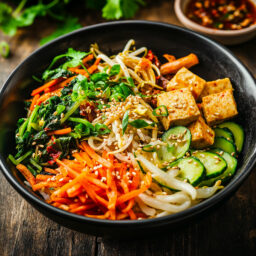
Korean Bibimbap
Whether you're a fan of Korean cuisine or looking to explore new culinary horizons, Bibimbap is a convivial dish, perfect for gathering around the table and sharing a meal full of textures and flavors.
Ingredients
For the Bibimbap:
- 200 g sushi rice or short-grain rice cooked
- 200 g firm tofu diced
- 1 carrot julienned
- 1 zucchini julienned
- 100 g soybean sprouts or mung bean sprouts
- 100 g fresh spinach
- 100 g mushrooms shiitake or button mushrooms, sliced
- 100 g kimchi (ensure it's vegan)
- 2 tablespoons sesame oil for cooking
- 1 green onion chopped
- Toasted sesame seeds for garnish
To flavor the tofu:
- 1 tablespoon soy sauce (or tamari for a gluten-free version)
- 1 clove garlic minced
- 1 teaspoon fresh ginger grated
- 1 tablespoon sesame oil for cooking the tofu
- Chili powder or a few drops of gochujang sauce (optional)
For the Gochujang sauce:
- 2 tablespoons gochujang paste Korean chili paste
- 1 tablespoon soy sauce
- 1 tablespoon sesame oil
- 1 tablespoon rice vinegar
- 1 teaspoon coconut sugar or maple syrup
- 1 clove garlic minced
Instructions
Prepare the Gochujang Sauce:
- In a small bowl, mix all the sauce ingredients (gochujang paste, soy sauce, sesame oil, rice vinegar, coconut sugar, minced garlic) until you obtain a smooth consistency.
- Adjust the taste according to your spice tolerance and set aside.
Cook the Rice:
- Rinse the sushi rice several times under cold water until the water runs clear. Cook it according to the package instructions.
- Once cooked, let it rest covered until ready to serve.
Prepare the Flavored Tofu:
- In a pan, heat 1 tablespoon of sesame oil over medium heat. Add the diced tofu and sauté for 5 to 7 minutes until it's crispy on all sides.
- Once browned, add the soy sauce, minced garlic, and grated ginger. Mix well to coat the tofu with these flavors.
- If desired, add a pinch of chili powder or a few drops of gochujang sauce.
- Cook for another 2 to 3 minutes to develop the aromas. Remove from heat and set aside.
Cooking the Vegetables (one large pan or two pans)
Option 1: Using one large pan
- If you have a large enough pan, you can cook all the vegetables at the same time:
- Heat a little sesame oil in a large pan over medium heat.
- Add the carrots, soybean sprouts, mushrooms, and zucchini to the pan all at once. Stir-fry them for 5 to 6 minutes, stirring regularly so all the vegetables cook evenly.
- Adjust the cooking time if needed to get the desired texture (carrots and mushrooms take a bit longer, while soybean sprouts and zucchini cook more quickly).
- Once the vegetables are tender but still slightly crisp, remove them from the pan and set aside.
Option 2: Using two pans
- First pan: Heat a little sesame oil. First, sauté the carrots on one side of the pan, and two minutes later, add the soybean sprouts on the other side. Carrots take about 3 to 4 minutes, while the sprouts cook in 2 minutes. Once cooked, set aside.
- Second pan: Heat a little sesame oil. Sauté the mushrooms on one side of the pan, and 3 or 4 minutes later, add the zucchini on the other side. Zucchini takes about 3 to 4 minutes, while the mushrooms need a bit more time to brown. Once cooked, set aside.
Assemble the Bibimbap:
- In bowls, place the sushi rice at the base. Arrange the sautéed vegetables, flavored tofu, mushrooms, spinach, and kimchi over the rice in a harmonious way, keeping each ingredient visible.
- Add a few spoonfuls of Gochujang sauce on top or serve the sauce on the side so everyone can adjust to their taste.
Garnish and Serve:
- Sprinkle with toasted sesame seeds and chopped green onion. Serve immediately.
Notes:
- Variations: You can add other vegetables like radishes, cucumbers, or bell peppers to vary the flavors and textures.Additional Proteins: You can also add tempeh to vary the protein sources.
Tried this recipe? Mention @MaisonMarmite or tag #MaisonMarmite
A recipe proposed by Maison Marmite